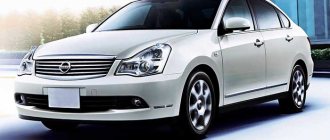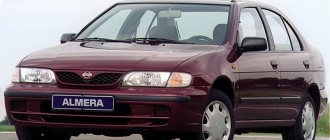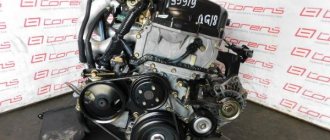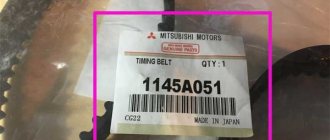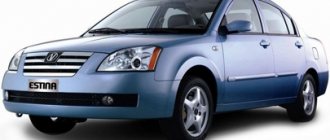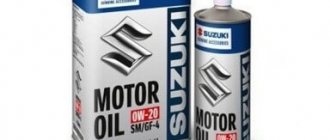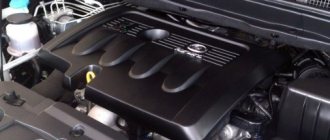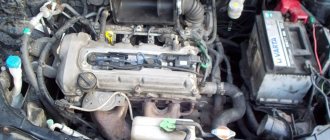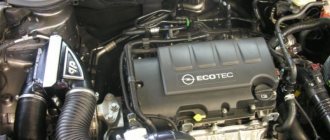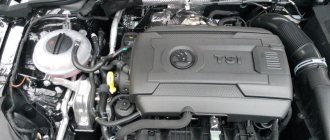First generation
Produced from 1995 to 2000. In fact, Nissan Almera became a replacement for the Nissan Sunny and Nissan Pulsar, which by that time had been in production for almost 30 years and were simply obsolete. The car was created to whet the interest of the buyer, who began to disappear in these cars.
The first versions of Almera were equipped with 1.4-liter (GA14DE) and 1.6-liter (GA16DE) gasoline engines; in addition, the engine line included one diesel unit with a volume of 2 liters (CD20).
The diesel engine was installed on cars for Europe; Almera was not supplied to Russia with such an engine. A year after the start of sales, the manufacturer added another gasoline internal combustion engine to the Nissan Almera gasoline powertrain lineup. This is a GTi engine with a displacement of 2.0 liters SR20DE (this engine was also aimed at the Old World; cars with such an internal combustion engine were not officially sold in Russia).
With all engines except the new SR20DE, the model was available as a hatchback (three and four doors) and a sedan. And the version with the GTi engine was sold only as a three-door hatchback. The first generation had excellent sales ratings around the world in the hatchback body.
All first-generation cars already had power steering, a driver's airbag, electric rear-view mirrors and a high-quality audio system as standard.
If we talk about richer configurations, they added modified plastic bumpers with built-in fog lights, alloy wheels, and a rear spoiler.
It is worth noting that the 2.0-liter Nissan Almera GTi had its own additional “aggressive” body kit, which was somewhat reminiscent of the stock body kit on the BMW M3 of that time. The body kit included side skirts, plastic wheel arch extensions, the GTi had a slightly higher suspension, and the car was also equipped with front and rear strut braces and had a so-called fast steering rack.
It must be said that the manufacturer was counting on very large sales of the Nissan Almera GTi, but this did not happen, although the car sold well, but did not become a hit and a “bomb” on the market in any of the sales countries.
From 1998 to 2000, a special modernized version of Almera was sold. The bumpers were changed and the body kit was modified; the rear spoiler had an integrated brake light. The changes were not large-scale, they affected “little things”. Another change: the telescopic antenna was moved from the A-pillar on the driver's side to the rear of the roof, and the antenna itself was replaced with a “bee-sting”. On the modified GTi, the optics and front indicators were surrounded by black, this made the car a little “meaner” visually.
The previous body kit had poor reviews for the quality of the plastic; it was brittle and brittle.
The updated body kit began to be made stronger, from new plastic.
That is why a pre-modernized version of the GTi with bumpers of an updated version or without splitters at all is not a rarity or a garage modification of car enthusiasts, it is a factory sales line from the manufacturer.
Diesel engines
The diesel Nissan Almera has a 2.2 liter engine. Its power gradually increased from 110 horsepower to 135. The unit is reliable, but not fast. In the combined cycle it consumes 6 liters of fuel. There are problems with the injection pump. Its resource does not exceed 210–220 thousand km. By 2003, the Common Rail system and turbocharger appeared. This increased the car's power.
Along with this option, an economical 1.5-liter diesel engine is available. Consumption – 4 liters per hundred km, 80 “horses” of power. Fuel injectors are replaced after 150,000 km.
The turbocharger is beyond repair. After 200 thousand km, you need to install a new one.
Poor fuel quality will cause the fuel pump to quickly break down.
Second generation
In 2000, the second generation Almera was released. The car was produced in three body versions: a three-door hatchback, a five-door hatchback, and a classic sedan. The design of the model has changed, it has become more modern. The sedan was in great demand in Russia.
Three years later, in 2003, the manufacturer restyled the second generation Almera, the car was given new optics, the front bumper was modified and a new 1.5-liter diesel engine was added to the range of engines.
In addition to this engine, the line of engines of the second-generation restyled Almera included Nissan QG gasoline engines (displacement of 1.5 liters and 1.8 liters, as well as a diesel engine with a turbocharger and direct injection YD22DDT, the displacement of this power plant was 2.2 liters, The buyer was also offered Common Rail - YD22DDTi. The transmission was “mechanical”, “automatic” was installed only on cars with 1.8-liter gasoline engines.
Second generation engines
The update of the second generation of the car in 2002 led to the appearance of 1.5 and 1.8 liter units. Fuel consumption in the city is up to 8 liters. These are more responsive engines with a power of 98 and 114 hp. pp., designated QG15DE, QG18DE. For fast sport driving, it is better to choose the second option.
The updated cars received an individual look and enhanced electronic content. Many processes in the engine are controlled electronically. If a mechanism or function fails, repairs should begin by checking the fuses of the mounting block. For example, if problems arise with the timing chain, a check appears on the instrument panel.
Nissan Almera Classic
This was a development in 2002, and since 2006 the car began to be sold in Russia. In our country, we fell in love with it, and car enthusiasts dubbed it “unkillable.” The difference from the regular Almera is in slightly modified optics; the model was assembled in Korea. The model turned out to be very simple, as the manufacturer intended. This car was supposed to capture the budget car market.
The car is very cheap to maintain. The main components (engine, gearbox) have an extremely long service life. This is a car that you can drive every day and not spend much money on its maintenance. Some of the disadvantages of the car include increased wear of brake pads and discs. Car enthusiasts say that it is sometimes necessary to change the elements of the brake system after 20-25 thousand kilometers.
Third generation
In the summer of 2012, Renault Nissan began assembling test units, production was established in Togliatti (), the car is based on the 2005 platform. Serial production of the car began at the end of 2012.
The car already traditionally looked stylish, modern, but without any frills. A simple and reliable car for the whole family for every day. The engine available for this car is a K4K petrol power plant, the engine displacement is 1.6 liters (102 horsepower), the engine is paired with either a manual gearbox or a classic automatic transmission.
As for the Russian assembly, which is often criticized. There is nothing terrible about the Russian assembly of Nissan Almera. The car itself was positioned as a budget car. That is, this is a car with less than ideal handling, poor sound insulation and other errors. Our Russian assembly did not spoil anything. There is no need to be afraid of it in this particular model.
The third generation of Almera is available only on the Russian market. The car is produced only in a sedan body.
Engine problems
A Japanese car, like most others, has its weak points. If we talk about the engine, this is:
- Problems starting the engine. The reason is most often electrical.
- Coolant leaking from the upper radiator hose.
- The appearance of the smell of gasoline in the cabin during the cold season due to insufficient tightening of the clamp on the fuel rail.
- Camshaft displacement during operation.
In addition to direct breakdowns, unpleasant aspects of operating the Nissan Almera Classic include the high cost of the fuel pump.
With proper care, these problems will not affect the service life of the Nissan Almera engine.
The most important part of proper car care is the timely replacement of its parts. During regular maintenance, it is necessary to diagnose all components and assemblies of the car, replace worn parts, and check the amount of fluids. On a Nissan Almera Classic, the timing chain must be replaced every 200-300 thousand km, the fuel pump usually lasts about 200 thousand, and the drive belt of the optional equipment is best changed every 100,000 km.
Nissan Almera 2015 cars are equipped with a 1.6-liter engine. Engine power 105 hp. What the engine life of this car will be also depends on the operating conditions and proper maintenance. Among drivers there is a certain distrust of engines assembled at AvtoVAZ, however, there are no clear examples of their poor quality. Locally assembled engines are installed not only on Nissans, but also, for example, on Lada Largus.
Which Almera to buy
You need to choose according to the condition of the car, and not according to the year of manufacture or some other parameter. Reviews of the cars characterize them as very reliable and unpretentious cars. Chain motors do not require chain replacement for a very long time. And if you service the car on time, the oil problem will begin to appear no earlier than 250-300 thousand kilometers. And then, oil consumption will be within the normal range from replacement to replacement.
If we talk about diesel engines, they are just as very reliable as gasoline internal combustion engines. Of course, if you buy a poorly maintained or “tormented” car, then you can have personal experience with all the problems of a “diesel”, in the form of a broken cylinder head gasket and all the ensuing problems, including the cooling system and other troubles.
Service
Maintenance of the K4M engine consists of timely replacement of consumables. They change with the following frequency, expressed in kilometers:
After another fifteen thousand kilometers, you should check the condition of the attachment belt, as well as the tightness of the cooling system and exhaust gas circuits. Adjustment of valves on the K4M power unit is not required, since there are hydraulic compensators.
Typical problems
We have already talked about poor noise insulation and increased wear of brake pads and brake discs. It has also already been said that after 250,000 kilometers, the engine begins to eat a little oil.
The metal of the car is not of the highest quality, but it is certainly an order of magnitude better than on our domestic cars. You can easily find the first generation Nissan Almera, which has traveled around Russia all its life and still has no serious problems in terms of metal corrosion.
When buying a car, listen to the engine, if it is running rough, then this may be a very serious problem; it may be worth considering another car for purchase, rather than doing repairs for the previous owner.
It is also recommended to always monitor the oil level to avoid serious problems one day. In general, the car is of very high quality and worthy, especially for the money that is asked for it on the secondary market. Consumables and components are sometimes downright cheap.
In general, almost all Nissan Almera repairs can be done independently. The machine is simple and repairable.
Nissan Almera engines
| 1st generation | 2nd generation | 3rd generation | Almera Classic | |
| K4M (1.6 liter 102 hp) | — | — | + | — |
| QG16DE (1.8 liter 107 hp) | — | — | — | + |
| QG15DE (1.5 l, 90 hp) | — | + | — | — |
| QG18DE (1.8 l, 114 hp) | — | + | — | — |
| QG15DE (1.5 l, 98 hp) | — | + | — | — |
| QG18DE (1.8 l, 116 hp) | — | + | — | — |
| GA14DE (1.4 l, 87 hp) | + | — | — | — |
| GA16DE (1.6 l, 99 hp) | + | — | — | — |
| CD20 (2.0 l, 75 hp) Europe | + | — | — | — |
| SR20DE (2.0 L, 143 hp) Europe | + | — | — | — |
It is worth saying that throughout the history of Nissan Almera, the buyer has been offered a sufficient number of different power units.
If you pay attention, there were two engines that were exclusively installed on the first generation of the car supplied to Europe. These were CD20 and SR20DE engines. In our country there are Almerias with such engines, but rarely. These are independently imported cars from European countries. There have never been official deliveries of such cars with these engines to Russia.
Engine Nissan Almera G15 1.6 liters
The Almera G15 sedan was equipped with only one engine and this is a classic Renault gasoline engine with a cast iron block for 4 cylinders, a 16-valve cylinder head with hydraulic compensators and a timing belt. The phase control system was not used, but separate ignition coils were present. This engine was combined with a 5-speed manual JH3 and a 4-speed automatic DP2.
This engine is generally quite reliable, but regularly causes small problems: sensors, ignition coils and thermostat often fail, leaks are common, and the engine speed regularly fluctuates due to drying out of the gaskets in the throttle assembly. You should also carefully monitor the condition of the timing belt, or if it breaks, the valve will bend.
| 1.6 l K4M manual gearbox5 | 1.6 l K4M automatic transmission4 | |
| Type | injector | injector |
| Fuel | gasoline AI-92 | gasoline AI-92 |
| Location | transverse | transverse |
| Cylinders | 4 in a row | 4 in a row |
| valves | 16 | 16 |
| Working volume | 1598 cm³ | 1598 cm³ |
| Power | 102 hp | 102 hp |
| Torque | 145 Nm | 145 Nm |
| Acceleration to 100 km/h | 10.9 s | 12.7 s |
| Speed (max) | 185 km/h | 175 km/h |
| Ecological Class | Euro 4 | Euro 4 |
| Consumption city | 9.5 l | 11.9 l |
| Flow track | 5.8 l | 6.5 l |
| Mixed flow | 7.2 l | 8.5 l |
How to replace the timing belt on such an engine
Source
Bottom line
Nissan Almera is a reliable horse for Russian roads, which is quite normal for the Russian AI-92. With this car you will always get to your destination and return back.
You can repair it right in the yard and you only need a standard set of wrenches. Car maintenance is equivalent to maintaining new Russian cars, and in some ways even cheaper.
A car for driving around the city every day. You won’t recognize her in traffic, but car hijackers aren’t interested in her. Low transport tax and low fuel consumption. We can safely say that the ten-year-old Almera is a direct competitor to new Russian and Korean cars from the same class, but for more modest money.

